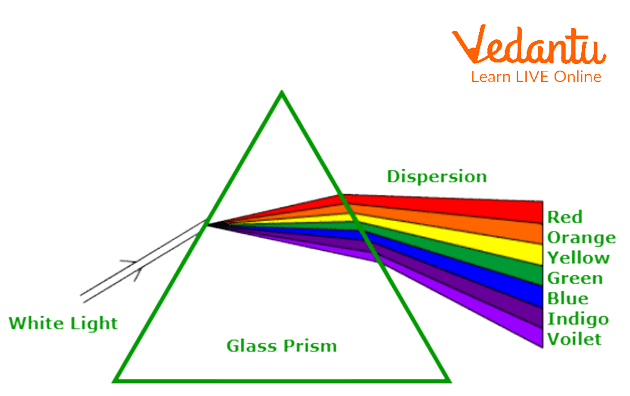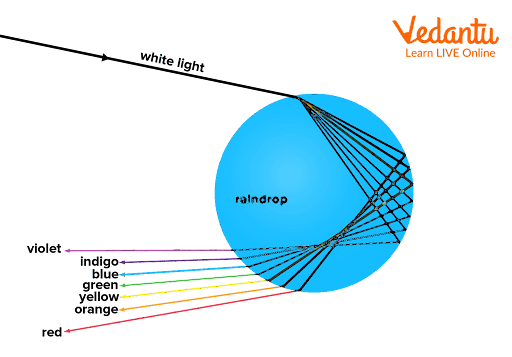




Visible Spectrum
Light is a form of electromagnetic radiation. It is composed of various wavelengths, each having its characteristics. VIBGYOR falls under the visible light region of the electromagnetic spectrum. It lies between the wavelength range of about $380 \ nm$ to $700 \ nm$. It has a frequency less than UV radiation and just greater than infrared radiation, as seen from the electromagnetic spectrum.
It is this visible light which enables vision. When light is reflected from a surface and reaches our eyes, we can see the object it was reflected from. It is also responsible for photosynthesis, transpiration, flowering, feeding habits, and many other related diurnal activities of plants and animals.
Splitting of White Light
White light is made of seven different colours, abbreviated as VIBGYOR. The VIBGYOR colours include- violet, indigo, blue, green, yellow, orange and red. Since frequency is constant irrespective, the wavelength for each VIBGYOR colour is directly proportional to speed. Therefore, the wave with a longer wavelength will have a higher speed. White light is made up of seven colours; each colour has a different wavelength. The colour with the longest wavelength is red; therefore, it has the lowest speed. Therefore, it shows the least bending during refraction. Whereas violet has the longest wavelength and, there, the fastest speed. It, therefore, refracts the most.
Due to differences in the speeds of each colour and thus different amounts of refraction, the white light splits into its seven constituent colours when refracted through a slab or prism. Therefore, through the prism, one can see the seven colours that constitute the white light as VIBGYOR.

Dispersion through a Prism Due to Different Angles of Bending of Each Colour
Characteristics of Each of VIBGYOR Colours
1. Wavelength
It is the distance between two crests or that between two troughs. The wavelength of various colours of VIBGYOR is
2. Frequency
It refers to the number of waves passing through a point per second. The frequency of various colours of VIBGYOR is:
3. Photon Energy
Energy carried by a single photon of that colour, is called its photon energy. The photon energy of various colours of VIBGYOR is
Formation of Rainbow
Rainbow is a case of natural dispersion of sunlight (white light). It is formed after sunlight passes through raindrops, which act as a natural prism. Therefore, a rainbow can only be observed when we look opposite the sun’s direction, i.e., our back is towards the sun. When light strikes the water droplets, some of it is reflected, and the rest is refracted. This refracted light, when it enters our eyes enable us to see the rainbow. Each colour deviates by a different amount at a different angle; each colour is visible separately. The circular arc formed is due to reflection, whereas the splitting of colours is due to refraction. VIBGYOR represents the rainbow colours.

Rainbow Formation Due to Dispersion through Raindrops (Image of VIBGYOR Formation)
VIBGYOR and Colour Related phenomenon
The source of the white light we receive on Earth is the Sun. Depending on factors like the sun's position, the scattering of light is affected, and thus we see different phenomena. Some examples include-
1. The Sky is Blue in Colour.
The colour of the sky is due to the dispersion of light into seven colours and the scattering of these colours. The wavelength of blue light is smaller than red. This wavelength of blue colour is comparable to the size of particles in the atmosphere. Therefore, the scattering of blue light is better. This makes the sky appear blue.
2. The Sunrise and Sunset Appear Red
During the sunrise and sunset, the sun is just at the horizon. Due to this, light has to travel a longer distance to reach the Earth. As a consequence, blue light, which has a higher scattering tendency, scatters away before reaching the Earth. Therefore, by the time the light reaches the Earth, only red hues remain. The sunrise and sunset thus appear red.
Summary
in this article, we have discussed the splitting of white light into VIBGYOR colours. We also studied the characteristics of colours and the formation of a rainbow. The colour-related phenomenon will give us an insight into the various natural phenomena such as colour of the sky during the sunrise and sunset, and the blue colour of the sky.
FAQs on VIBGYOR- A spectrum
1. What does the acronym VIBGYOR represent in the context of Physics?
VIBGYOR is an acronym used to remember the sequence of colours that make up the visible spectrum of light. The colours are: Violet, Indigo, Blue, Green, Yellow, Orange, and Red, arranged in order of decreasing frequency and increasing wavelength.
2. How does a prism cause white light to split into the VIBGYOR spectrum?
When white light enters a prism, it undergoes refraction. Since white light is a mixture of seven different colours, and each colour has a slightly different wavelength, they bend at slightly different angles. Violet light has the shortest wavelength and bends the most, while red light has the longest wavelength and bends the least. This difference in bending angles causes the colours to separate, creating the visible spectrum known as VIBGYOR. This phenomenon is called dispersion.
3. What is the primary difference between the dispersion and scattering of light?
The main difference lies in the mechanism and the resulting visual effect:
- Dispersion is the splitting of white light into its constituent colours (VIBGYOR) when it passes through a refractive medium like a prism. It occurs because the speed of light in the medium varies with wavelength. A key example is the formation of a rainbow.
- Scattering is the process where light is absorbed and then re-emitted in various directions by particles in a medium. The amount of scattering depends on the light's wavelength and the particle size. A key example is the blue colour of the sky.
4. Why do sunrise and sunset appear red, while the midday sky appears blue?
This phenomenon is a direct result of the scattering of sunlight by Earth's atmosphere. At midday, the Sun is overhead, and sunlight travels a shorter distance through the atmosphere. Shorter wavelength light, like blue and violet, is scattered more effectively by air molecules, making the sky look blue. During sunrise and sunset, sunlight must travel a much longer path. By the time it reaches our eyes, most of the blue light has been scattered away, allowing the longer wavelength light, like red and orange, to dominate what we see.
5. What are the approximate wavelengths for the different colours in the VIBGYOR spectrum?
The visible spectrum of light spans a range of wavelengths from approximately 380 to 700 nanometres (nm). The typical wavelength ranges for the VIBGYOR colours are:
- Violet: 380–450 nm
- Indigo/Blue: 450–495 nm
- Green: 495–570 nm
- Yellow: 570–590 nm
- Orange: 590–620 nm
- Red: 620–750 nm
6. Why is red light, which deviates the least, used for danger and traffic signals?
Red light is used for important signals because it has the longest wavelength in the visible spectrum. Due to this property, it is scattered the least by atmospheric particles such as fog, rain, or smoke. This minimal scattering allows red light to travel the farthest distance through the air without losing its intensity, ensuring it remains highly visible from afar, which is crucial for safety and warning systems.
7. If a prism splits white light, why doesn't a standard rectangular glass slab produce a visible spectrum?
A rectangular glass slab does cause dispersion when light enters it. However, the slab has two parallel faces. The dispersion that occurs at the first face (air-to-glass) is perfectly reversed and cancelled out when the light exits at the second, parallel face (glass-to-air). The separated colours emerge parallel to one another and effectively recombine to form white light. In a prism, the two refracting surfaces are non-parallel, which allows the separated colours to diverge at different angles and remain distinct, thus forming a visible spectrum.





















